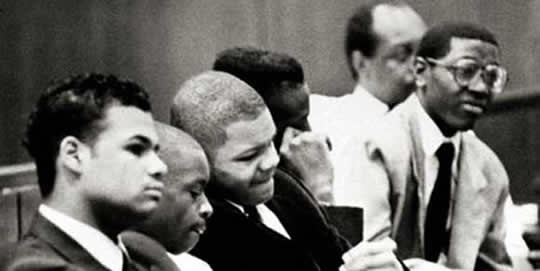 Ken Burns an co-directors David McMahon and Sarah Burns tell a straight forward story ripped from the headlines of 1989. New York City , under Mayor Ed Koch, was struggling with a major crime situation fueled by crack and an intrenched underclass.
Ken Burns an co-directors David McMahon and Sarah Burns tell a straight forward story ripped from the headlines of 1989. New York City , under Mayor Ed Koch, was struggling with a major crime situation fueled by crack and an intrenched underclass.
Five African American and Latino teenage boys were railroaded by the Justice system, lead by the elite detective section of the Northern WHAT, and convicted of a rape and attempted murder. One served time in an adult prison. Tried in the headlines, the Media frenzy was a lynching in print.
Minutes into the film, the filmmakers play the audio confession of the actual attacker, a serial rapist named Matias Reyes, allowing the audience to savor the ripe ironies of a broken justice system impatient for conviction, a knee jerk media, and the racist subtext still rampart in our culture, each of which contributed to locking up 5 innocent boya and losing them their childhoods.
The boys went to Central Park, where they joined a large group of teens “wilding” and, to the horror, the shy young men watched random harassment and violent attacks on joggers. What they didn’t witness was the rape of WHO
On April 20th, 1989, the body of a young white jogger, raped and beaten almost to death was discovered in Central Park. Five African American and Latino teenage boys, three of them already in custody for a series of random attacks in the Park the night before, and two more boys who lived in the same projects, were held, browbeaten and fed confessions, while their family members waiting outside. Promised to be released if they could tell a credible story, the first three teens created largely fictional accounts, supplied with names and details by the detectives. Those video taped confessions put them away. Only one juror held out until the pressure from his peers made him fold.
Despite DNA recovered at the scene, lake of witnesses and inconsistent narratives, the five youth were tried and sentenced, serving between 6-13 years. Awaiting parole, none of the young men accepted parole predicated on confession and remorse. They continued to maintain their innocence.
Matias Reyes came forward in 2002 and a judge vacated their convictions, A Civil suit is pending.
The startling documentary, “The Central Park Five” which premiered in Cannes is one of two documentaries opening this season ( “West Of Memphis” is the other) that would not have bee,n possible before projects The Innocence Project and other member organizations of the Innocence Network , began fighting to to exonerate wrongly accused prisoners using exiting DNA evidence.
Founded in 1992 by Barry Scheck and Peter Neufeld, the Innocence Project freed 292 wrongfully convicted people, including 17 who spent time on death row.
In an interesting side-note, New York City is demanding that documentary filmmaker Ken Burns hand over footage of the movie he made about the wrongfully imprisoned “The Central Park Five,” inn order part of the to defend itself against multi-million dollar federal lawsuits filed by some of the exonerated men .
Lawyers for New York City are seeking the unpublished interviews and unreleased footage from Burns’ company Florentine Films. But Burns, daughter, Sarah Burns, and David McMahon, who co-wrote and produced the film plan to fight, citing the New York state shield laws designed to protect journalists from compromising their sources. A MUST SEE.

